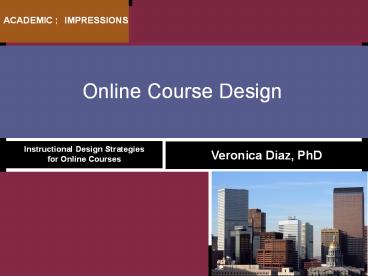A Comprehensive Approach to Designing Online Courses - PowerPoint PPT Presentation
Title:
A Comprehensive Approach to Designing Online Courses
Description:
ACADEMIC IMPRESSIONS Online Course Design Veronica Diaz, PhD Instructional Design Strategies for Online Courses Presenters Veronica Diaz, PhD Instructional Technology ... – PowerPoint PPT presentation
Number of Views:422
Avg rating:3.0/5.0
Title: A Comprehensive Approach to Designing Online Courses
1
ACADEMIC IMPRESSIONS
Online Course Design
Veronica Diaz, PhD
Instructional Design Strategies for Online
Courses
2
Presenters
- Alisa Cooper, EdD
- English Faculty
- South Mountain Community College
- Maricopa Center for Learning and Instruction
Technology Faculty Developer
- Veronica Diaz, PhD
- Instructional Technology Manager, Maricopa Center
for Learning and Instruction, Maricopa Community
Colleges - Adjunct Faculty, NAU
3
Converting or Creating?
- Pros and cons
- Pitfalls and opportunities
4
Starting with Objectives
- Blooms Taxonomy
- Assessment
- Depth of learning
- First step in creating modules
5
Blooms Taxonomy
- Focus on learner performance/outcomes
- For each module
- What do they need to know?
- What do they need to be able to do?
- What will they know as a result of my
instruction? - What can they learn in other ways?
6
Why Modules?
- 7 /-2 rule
- Support consistency in look and feel
- Easier to find course content
- Content becomes/feels more manageable
- Prevents information overload
- Allows students to focus on content rather than
form
Source Blending In, March 2007
7
Module Possibilities
- Content chunks
- Let the content set the chunks
- Content organized in conceptually related blocks
- Apply past experience
Source Blending In, March 2007
8
Course Organization
- Dates
- Topic
- Readings
- Section
- Unit
- Module
9
3 Basic Redesign Steps
- Identify course content for each module
- Write learning objectives for each module
- Consider each learning objective or each learning
objective set and reference and utilize diverse
instructional strategy possibilities
10
(No Transcript)
11
5 Principles of Successful Course Redesign
- Redesign the whole course.
- Encourage active learning.
- Provide students with individualized assistance.
- Build in ongoing assessment and prompt feedback.
- Ensure sufficient time on task and monitor
student progress. - http//thencat.org/PlanRes/R2R_PrinCR.htm
12
Your Online Course Toolbox
- Worksheets
- Using Blooms Taxonomy for Objective Development
- Mapping Your Course
- Resources
- Course re(Design) Resources wiki page
- Sample face-to-face syllabus
- (re)Design handouts 2
13
Mapping Your Course
- Step 1
- Go back to Blooms handout, where you started
mapping out the objectives for your course and
indicated the level of Blooms addressed
14
Mapping Your Course
- Step 2
- Transfer objectives (some) to Mapping Your Course
handout - Step 3
- What does the instructor do?
- What does the learner do?
15
Mapping Your Course
- Step 4
- Identify a module or chunk
- Add more detail to objectives
- Indicate instructor and student activity
- Indicate Blooms level addressed
- Consider alignment/relationship to other content
16
CONTACT INFO
- Veronica Diaz, PhD
- drvdiaz_at_gmail.com
- 480.731.8297































